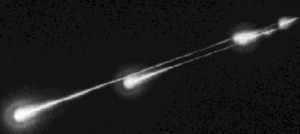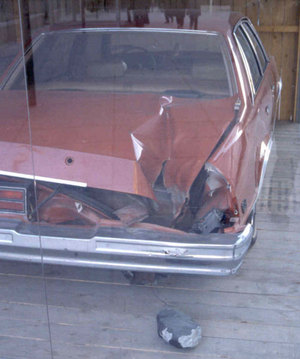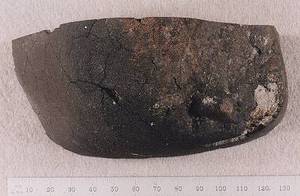Each year approximately 40,000 tonnes of extraterrestrial material, most of it dust, bombards the earth. But where does it come from, and why does it land here?
Visitors from space arrive on the Earth with amazing frequency, not as alien monsters or little green people in flying saucers, but as meteorites, extraterrestrial material ranging from the tiniest of dust grains to enormous impact crater-forming bodies. Meteorites were formed at the birth of the Solar System, about 4,560 million years ago. We have no material on Earth this old, so it is only by studying meteorites that we can learn about the processes that shaped our Solar System and our planet.
Our Sun was born in a rotating cloud of gas and dust, called a nebula. Gradually this cloud collapsed and dust grained joined together to form bigger and bigger bodies, eventually producing the Sun and planets. The Sun is at the centre of the Solar System, and all the planets orbit around it.
The Asteroid Belt, the place from which most meteorites come, lies between Mars and Jupiter. Asteroids orbit the Sun at a distance three times that of the Earth from the Sun -- three Astronomical Units (AU), or 450 million kilometers. There are several thousand asteroids, the largest of which is about 1,000 kilometers across (the Earth has a diameter of about 13,000 kilometers). These rocky, metallic or carbon-rich bodies are the remaining after the planets formed; Jupiter's gravitational pull prevented them from joining together to form a single planet.
The asteroids are in stable orbits around the Sun, but occasionally, thanks to the influence of Jupiter, the orbit of an asteroid is altered so it collides with another and breaks up. Fragments of broken asteroid fall to Earth as meteorites.
We know that meteorites came from the Asteroid Belt as fireballs created by incoming meteoroids because they have been photographed. From their direction and speed, scientists can calculate the orbits of these meteoroids, and all are seen to extend out to the Asteroid Belt.
One of the most recent meteorite falls occurred on a Friday afternoon in October 1992. at Peekskill, New York.

|
| ©Sara Eichmiller |
| Sara Eichmiller's extraordinary photo of the Peekskill fireball of October 9, 1992 |
The track of the fireball was recorded on several video cameras, mostly by members of the public attending outdoor football games. The video footage has been edited together to produce a film of the fireball travelling over the northeastern U.S.
The meteorite eventually landed in the boot of a car.

|
| ©Pierre Thomas |
| The Peekskill meteor of 1992 was captured on 16 independent videos and then struck a car. |
As well as meteorites from the Asteroid Belt, Earth has also received more than a dozen meteorites that have come from the surface of the Moon. Lunar meteorites have been compared directly with samples brought by the Apollo and Luna missions. The surface of the Moon is covered in the craters caused by impacting bodies. The force of these impacts is sometimes sufficient to throw material off its surface, and it is this that arrives on Earth. In the same way, rocks have come to us from Mars: scientist have identified 12 Martian meteorites.
The very bright fireball often associated with an incoming meteoroid is the result of frictional heating as the body travels through the atmosphere. Only the outermost surface melts; the resulting droplets of molten material are carried away by the speed of passage. Finally, as the molten surface rapidly cools to a glassy coating, or fusion crust, which helps scientist identify meteorites. The interior of a meteorite remains cool and unchanged, and meteorites are cold when they land.
The very smallest of micrometeorites do not melt as they pass through the atmosphere, whereas those that are slightly larger melt and form tiny rounded droplets. Very large meteorites fall only every million years or so. Arizona's 1.2 kilometre-diameter, Meteor Crater, was produced by the impact of an iron meteorite about 50,000 years ago. The original meteorite weighted up to 25,000 tonnes, and would have been about 35 to 40 metres across, but most of it was vaporised by the impact. A really big meteorite, probably about 10 kilometres in diameter, fell at Chicxulub on the Gulf of Mexico about 65 million years ago. As well as forming a crater 200 to 300 kilometres across, the environment changes brought about the impact are thought by many scientist to have resulted in the extinction of the dinosaurs. Several smaller meteorites weighted about a kilogram fall on the Earth every year, but only five or six are seen to fall. The last one seen to fall in England was in May 1991, at Glatton, near Peterborough. This stony meteorite weights just over half a kilogram and fell through a hedge of conifers in the garden of a Mr Pettifor, who was started by the whining noise it made as it hurtled through the air.
Meteorites are pieces of ancient material that survive their fall to Earth from space. There are three main types of meteorite (stone, iron and stony-iron), reflecting their main composition. Meteorites are named after a place near where they fall or are found. Most meteorites (96 per cent of falls) are stony, made up of the same minerals as many terrestrial rocks, minerals containing silicon, oxygen, magnesium, iron and calcium. Stony meteorites can be sub-divided into those which have formed from melts of their parent bodies (like terrestrial igneous rocks), and those which have remained unchanged since formation, or aggregation. The latter are known as chondrites, after the small rounded droplets of once-molten material (chondrules) they contain.
Iron meteorites comprise, as their name implies, mainly iron metal, and generally contain between seven to 15 per cent of their weight in nickel. These meteorites have been formed during the melting of the parent bodies from which the meteorites originated.
The final main sub-division of meteorites is the stony-irons: a mix, as the name suggests, of stone and metal. These are very rare meteorites and beautiful in appearance. They are produced from the intergrowth of iron and magnesium silicate minerals with iron metal. Like iron meteorites, they were formed during the melting of their parents.
Different types of meteorites provide evidence about events that have occurred as the Solar System formed and evolved. Iron meteorites are the closest physical analogy we have to the material that forms the Earth's core. The stony meteorites represent material from the core/mantle boundary of their parent body.
The most primitive meteorites, the CI carbonaceous chondrites, are rich in water, sulphur and organic compounds. These might be the material remaining from comets, which are essentially a mixture of ice and dust, after all the ice has evaporated. It is material like this that brought volatiles to the newly-formed Earth, and helped established its atmosphere and oceans.
Several of the 12 Martian meteorites found on Earth contain pockets of glass formed during the shock event that ejected them from the surface of Mars. When this glass is melted in the laboratory, gas that was trapped inside the glass by the shock is released and compared with that analysed by the Viking space probes in 1976. The compositions are similar, although Martian meteorites also contain carbonate grains, produced below the surface of Mars when water circulated through the planet. A recent report by scientists from NASA has described evidence for fossilised martian bacteria inside these carbonate patches, showing that life might once have existed there. By studying meteorites like this, we can learn about events that have taken place in the past on our neighbouring planet, a planet whose surface now appears to be dry.




Reader Comments
to our Newsletter